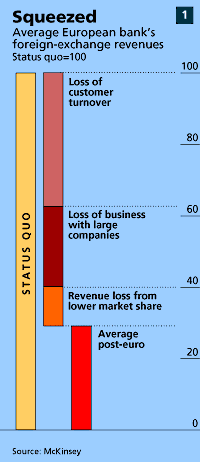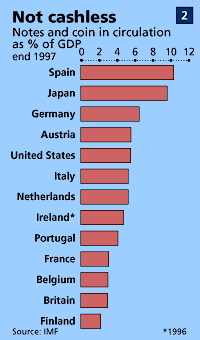EURO BRIEF
Unready for blast-off
The arrival of the euro will mean massive adjustments for every business operating in Europe. Yet most firms are sanguine about the trouble these will cause. As the fourth in our series of briefs explains, they may live (or die) to regret it
Shopping and
changing
Search archive
Starting on January 1st 1999, European firms will be allowed, though not required, to keep their books and conduct business in euros (a system known as no-compulsion, no-prohibition). Banks have to be ready to handle accounts and conduct business in both euros and national currencies at the same time. At this stage, a host of practical problems will appear. Staff must be trained; software has to be rewritten on a huge scale; some legal contracts may need checking.
Still more difficulties will emerge in 2002, when the euro moves beyond a virtual existence in accounting systems and is actually issued in the form of notes and coin. There will be practical problems with distributing the new currency; with converting machinery that takes coins; with setting prices; and with avoiding outbreaks of fraud.
Most big firms intend to switch to the euro from the start of 1999. A survey earlier this year of 124 large firms, conducted by the Association for Monetary Union in Europe, found that more than half would adopt the euro immediately for their accounts and treasury, although not necessarily for all other operations. Many companies—even the 49% of firms that told another recent survey they were well-prepared for the euro—may find the change traumatic.
Early switching by big firms will force many smaller companies to switch, as suppliers are urged to submit bills and take payment in euros. But many small firms are hopelessly ill-prepared. A study in France found that only a third of firms with ten or fewer employees had done anything at all to prepare for the euro, compared with 70% of firms employing between 100 and 500 people. That is partly because small firms have fewer staff to devote to the euro: Philips, a Dutch electronics giant, reckons that it has 1,500 people (out of a staff of 275,000) working on the joint challenges of the euro and the millennium bug.
Don’t bank on it
Banks have, understandably, done the most to prepare, for their business is the most immediately affected. Conversion rates will be set on December 31st; a convention is in place for rounding up; rules exist for multi-currency transactions (any conversion must always go via the euro to limit the compounding of rounding errors, a cumbersome procedure called triangulation).
Banks are having to make huge investments to prepare. Deutsche Bank plans to spend DM500m ($300m). They will still have to carry some of the cost of handling multiple currencies for several more years: between 1999 and 2002 banks must exchange any currency issued by the 11 euro countries, while no longer being allowed to charge commission.
The banks’ workload will also increase. A survey of small and medium European firms by Deloitte & Touche, an accounting firm, found that more than half expected their bank to be their main source of practical help on the euro. But the euro will also do away with some important bank revenues. Intra-euro foreign-exchange business, for instance, worth about $3 billion a year, will disappear; overall, foreign-exchange revenues for EU banks are expected to drop by 70% (see chart 1).
For most businesses, the biggest cost of adapting to the euro is that of updating information systems. But consultancies come up with widely differing guesstimates. One, Cap Gemini, puts adaptation costs at between 0.5% and 2% of a typical firm’s sales. About half will relate to information systems; a quarter to changes such as consolidating back-office functions; and the rest to training and customer relations. Moody’s, a rating agency, puts the price-tag for conversion at $100 billion. The Gartner Group, another IT consultancy, puts the cumulative cost at between $150 billion and $400 billion.
One reason for these wide ranges is uncertainty about what will be needed. Another is that the no-compulsion, no-prohibition system gives firms some flexibility about what they do and when. Some firms may also choose to treat the switch to the euro as an opportunity to gain a strategic edge over competitors, meaning they do more than the minimum required.
 |
|
The bare minimum will be demanding enough. Merely going through the operating systems in the 75m PCs in businesses in Europe and teaching them (and the keyboards attached to them) to support the new euro symbol, could cost between $10 billion and $20 billion. However, the trickier part of updating information systems will be applications software.
Upgrades for standard packages such as word-processors and spreadsheets are straightforward. Many are already available—indeed, Microsoft’s code to teach Windows how to draw a euro can be downloaded from its website. But changes to small applications that may have been customised to suit individual users could be much harder. And, if users update their machines at different times, data representing a sum in D-marks, say, could easily be put into a spreadsheet with sums in euros, making the whole thing meaningless. This could muck up numerical thresholds, such as credit limits, as well as peppering accounts with errors.
Better call your lawyer
In theory, at least, the arrival of the euro should make little difference to firms’ legal obligations on contracts. Two regulations adopted by the Amsterdam summit in June 1997 set the legal framework for the new currency. The regulations should ensure the continuity of contracts, making clear that, from the end of the transitional period, all references to national currencies in legal instruments are to be read as references to the euro.
Lex monetae, a principle of international law, should also ensure that European contracts will continue to be valid in other countries. Several American states that do a lot of international business, including California, Illinois and New York, have passed legislation recognising the euro and enshrining the continuity of contracts during the transition period.
Yet even enforceable contracts can be drawn up by crooks. The general confusion as prices in the euro-11 area are re-expressed in euros will surely provide a smokescreen for various kinds of fraud. An independent contractor updating a firm’s book-keeping software might, for example, funnel off into a private bank account all the fractions of cents that disappear in rounding. Several such schemes, a high-tech equivalent of the old practice of coin-clipping, were uncovered in Britain after decimalisation in 1971.
The hard stuff
When euro notes and coins are introduced in 2002, a new set of problems will emerge. Old and new currencies will circulate side by side for, at most, six months, during which time the entire note issue and coinage of the 11 member countries will have to be replaced. Distributing the new currency will be a logistical nightmare for Europe’s banks (which will hand out the new notes) and shops (which will be the main source of coins). It will place unprecedented demands on safe transport and storage. Many of the worst problems will hit retailers, who in some countries will be in the thick of the January sales, the period when shops are busiest and the amount of money in circulation is largest (see article).
Mass production of the notes—by the 11 euro-area central banks—will start in early 1999. The aim is to have produced 13 billion notes, in seven denominations (5, 10, 20, 50, 100, 200, 500), by the time the new currency goes into circulation on January 1st 2002. American officials worry that the 500 euro note (worth $600) will make Europe’s new currency the medium of choice for crooks and money-launderers: a wallet of 500 euro notes will replace a suitcase of $100 bills, America’s largest denomination.
 |
|
At least the coinage will keep national symbols. Euro coins, which will be produced in eight denominations (one, two, five, ten, 20 and 50 cents, plus one and two euros), will have a common side, carrying the value and a map, and one national side. France, for instance, will retain Marianne and the sower who grace various franc coins.
One of the biggest practical problems facing the ECB is to estimate the demand for euros and to ensure their distribution. Nobody knows how many notes and coins will be needed—habits vary widely among euro-area countries (see chart 2). Coin production has already seen some setbacks. Minting the coins is under way, as a far greater number of coins than notes will be needed: some 76 billion coins are in circulation in the euro countries.
France has had to melt down 9m ten-cent coins, after the European Blind Union said they were confusing. Vending-machine makers had also demanded changes after discovering that the electrical properties of some proposed coins, important for distinguishing between them automatically, were too alike.
Adjusting to a whole new set of values will bring special difficulties. Italians will have to cope with numbers three orders of magnitude smaller than those they use now; the Irish, on the other hand, whose pound is worth about 1.25 euros, will be dealing with new prices close enough to the old ones that there is a danger of confusion. Even today, it is possible to find French people talking in old francs, which were replaced 40 years ago.
One other result will be problems for pricing policy. If companies want to stick to the psychologically significant price points such as 9.99 or 0.49, they may have to change the units in which their products are sold.
That will create opportunities for the sort of price-gouging that often accompanies currency changes. Indeed, all fraud, including straightforward overcharging, will be harder to detect during the early life of the euro, since people’s instincts for what prices ought to be will not have adjusted.
Forgers may make the most of the change-over in 2002 as well. Euro notes will be full of clever security features, but the early stages, when the new money is unfamiliar, will still be a chance to pass counterfeits. So will the numerous different national designs for coins. To add to the security worries, a hologram stamp that was to be one of the safety features for euro notes was stolen from an Air France flight from Paris to Munich in May. The ECB insists it was only a trial model.
National mints and the ECB do at least have a few years left to get themselves organised for the solid forms of the euro. With only two months to go before the ethereal version arrives, firms that are not yet ready—and even many that think they are—may come a cropper long before then. The cost of the transition to the euro could turn out to be far bigger than expected. That makes it all the more vital that European governments and businesses deliver on the potential benefits of the single currency.